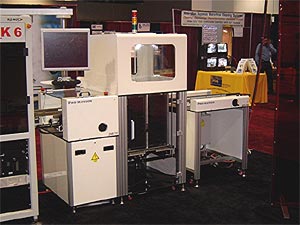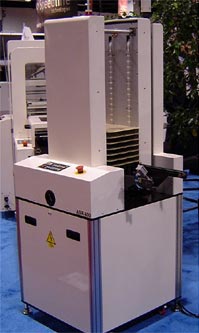2005 Articles
Handling Failed Product after AOI
A series of setups are available for in-line or offline rework.
The impact of automated optical inspection systems on output quality is well documented. After selecting the AOI machine that best fits the manufacturer’s process, the remaining decision is to define how to disposition, handle, repair and reintroduce failed product for second validation.
Here we explore common manufacturing options for handling product after AOI and considerations for: sorting passed and failed inspected product; process flow for both dispositions (what to do with them); in-line or offline repair; reintroduction of product for second AOI validation; and operator requirements.
Manufacturers deploying optical inspection need to consider how this automation might affect the process flow and cycle time of their line, floor space required for the reintroduction of failed product back into the AOI for second validation and operator requirements (cost/time).
When exploring PCB handling equipment there are several viable solutions. For in-line and offline operations with batch repair processing and a part-time operator, these include:
- Sorting station (removable magazine style).
- Diverting and rerouting (into magazine line unload station or accumulation conveyor).
- Sorting station (vertical buffer style) with rework station positioned downstream.
For in-line operations with continuous flow repair processing and a full-time operator, these include:
- Diverting and rerouting (into repair station with product return).
- Inspection followed by a PASS/FAIL multi-tier rework conveyor
Batch processing. Sorting station/removable magazine and sorting station/vertical buffer are good solutions for manufacturers that desire to schedule rework of failed products at a time of their choosing. These options permit optimization of existing personnel by batching all rework at a scheduled time (versus maintaining a full-time operator at the station).
A removable magazine sorting station (Figure 1) accepts PASS and FAIL signals from AOI after each product inspection. These stations are generally configured with an in-feed buffer conveyor that contains a pneumatic pusher followed by a magazine on an elevator platform. Stations should also include programmable slot selection that permits product spacing within the magazine (e.g., every 10 mm, 20 mm, 30 mm, etc.).
 |
| FIGURE 1: The removable magazine sorting station places failed product into magazines. |
Communication is generally established by adding two additional pins to the SMEMA interface that directs the sorting station. If a PASS signal is received by the station, product flows onto the buffer conveyor and is passed through the magazine to the next process. If a FAIL signal is received, the product is placed into the magazine for future disposition. The magazine indexes to the next slot, safely storing the product. The magazine continues to fill with product (no rework is immediately required) until full. When full, the station alarms, alerting the operator that the magazine must be changed. The full magazine is generally transported to a rework area until an operator is scheduled to conduct the repairs. Most removable magazine stations occupy 1.2 to 1.5 meters of line space. Cycle time to buffer a product inside the magazine is about 3 to 4 seconds and to pass a product through is 5 to 8 sec. This process requires only a part-time operator and the number of products that may be buffered is slot spacing-specific (e.g., 10 mm spacing offers 50 product capacity while 3 mm spacing only offers 16 products). Some AOI systems include a bar code reader that interfaces into the AOI and permits the operator to scan each product for failure analysis at the rework station.
Similarly, a divert and reroute setup may incorporate either a 90° turning station or lane shuttle to route failed product into either a magazine line unloader or accumulation style conveyor. The magazine line unloader offers functionality similar to the removable magazine sorter station, but may be configured with higher capacity (since unloaders can hold multiple magazines). They also occupy much more floor space (due to foot print). A 90° turning station is generally about 1 m2 while lane shuttles may be 600 to 800 mm wide and from 1 to 3 meters deep or greater (line specific).
Cycle times vary and are based upon product size. Product reintroduction may be accomplished by manually placing repaired products onto a small entry conveyor prior to AOI for revalidation.
 |
| FIGURE 2: The in-line vertical sorting station buffers failed product to a waiting queue for disposition. |
An in-line vertical sorting station (Figure 2) offers similar convenience but operates slightly differently. This station accepts PASS and FAIL signals from AOI after each product inspection. Communication is established through two additional pins added to the SMEMA interface that directs the vertical sorting station. If a PASS signal is received by the station, product flows onto the conveyor and is passed to the next process. If a FAIL signal is received, the product is transferred onto the conveyor and stopped where the vertical buffer belts are located, then vertically raised (buffered) for future disposition. The buffer continues to fill with failed product (no rework immediately required) until full. These types of buffering stations may include programmable slot selection that permits product spacing within the buffer (e.g., every 10 mm, 20 mm, 30 mm, etc.) while others may offer fixed spacing. When full, station alarms alert the operator that the buffer must be purged. (Note: In some manufacturing operations, product is generally purged to the small exit conveyor portion of the station, where it is removed by an operator. However, some operations may elect to have a 1 meter long rework station after this unit. By changing the rework station from bypass to audit mode, the buffer can offload failed products to this station for inspection and rework.)
Process cycle time to buffer a product is 2 to 3 seconds. This setup would use a part-time operator but is more labor intensive because a run of failed product could keep the operator busy. Product reintroduction may be accomplished by manually placing repaired products onto a small entry conveyor prior to AOI for revalidation.
Diverting and rerouting setups incorporate a complete in-line process and automatic product reintroduction. Most incorporate a 90° turning station in front of the AOI station (to reintroduce product after repair) and either a 90° turning station or bi-directional lane shuttle to route failed product from the line and toward a repair station after AOI.
Each station after AOI accepts PASS and FAIL signals from the machine after each product inspection. Communication is established through two pins being added to the SMEMA interface that directs the rerouting function. If a PASS signal is received by the station, product flows through the station and is passed through to the next process. If a FAIL signal is received, the product is rerouted. When a turning station is used, FAIL product is rerouted at a 90° angle and passed to either a conveyor or a rework station (depending on floor space and layout). If a lane shuttle is used, failed product is accepted, then shuttled to another position and transferred to either a conveyor or rework station. Both these solutions route failed product toward the rear of the main production line and wrap around the AOI. (Note: A passageway station is recommended to permit access to the rear of the AOI.)
Cycle times vary and are based upon product size. Capital equipment costs can be greater, and would be based upon the actual configuration selected for handing and disposition failed product because there are many more stations and conveyors.
An in-line, multi-tier rework station offers convenience by permitting products to be repaired in-line, without stopping the line flow. These stations accept PASS and FAIL signals from AOI after each product inspection. Communication is established through SMEMA protocol that directs the rework station. If a PASS signal is received, product flows onto the conveyor and is passed through to the next process. If a FAIL signal is received, the product is transferred onto the conveyor and stopped, then vertically raised to a position where an operator may further inspect and work on the product. In turn, an additional conveyor rail set lifts into position to permit passed products to continue to flow underneath. When the inspection or repair has been completed, a button-operated signal returns the conveyor’s top rail to pass line height and transfers product through the remaining production process.
Gary Goldberg is president of Pro-mation Inc. (pro-mation-inc.com); gary_goldberg@pro-mation-inc.com.
Press Releases
- Tagarno Sees Strong US Sales Growth in 2025, Driven by T50 and Software Demand
- Kimball Electronics Sets Date for Ribbon-Cutting at New Indianapolis Medical Manufacturing Facility
- Nordson’s SELECT Synchro Selective Soldering System Helps Kamstrup Advance Automation, Increase Output 20%, and Reclaim 6 Meters of Factory Floor Space
- Pinnacle Technology Group, Now PTG Electronics, Launches New Brand Identity, Strengthening Its Commitment to Innovation and Progress







